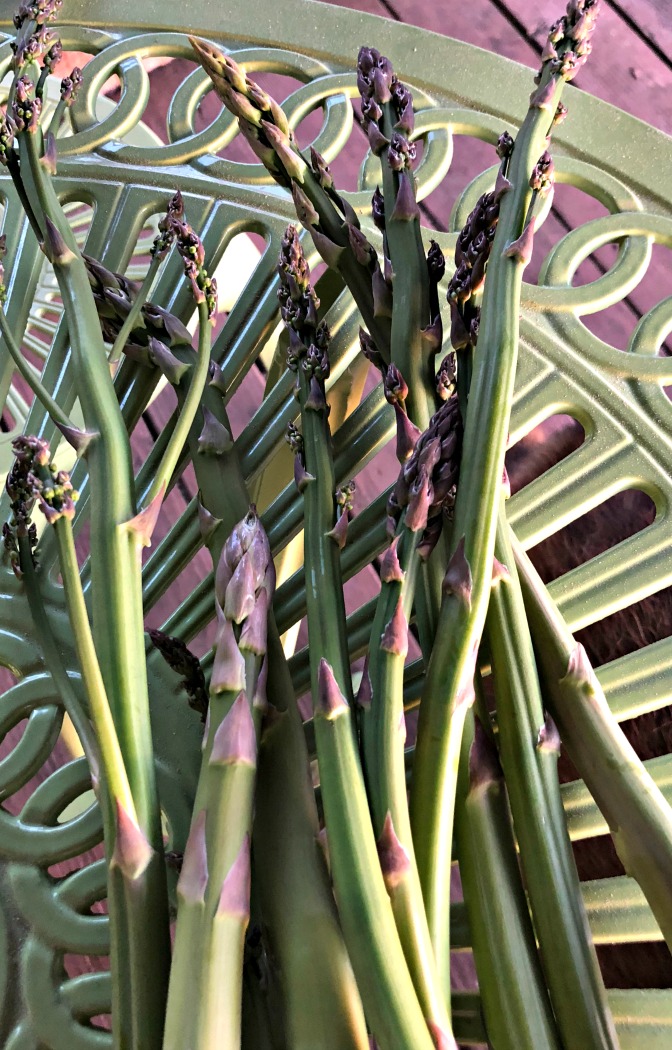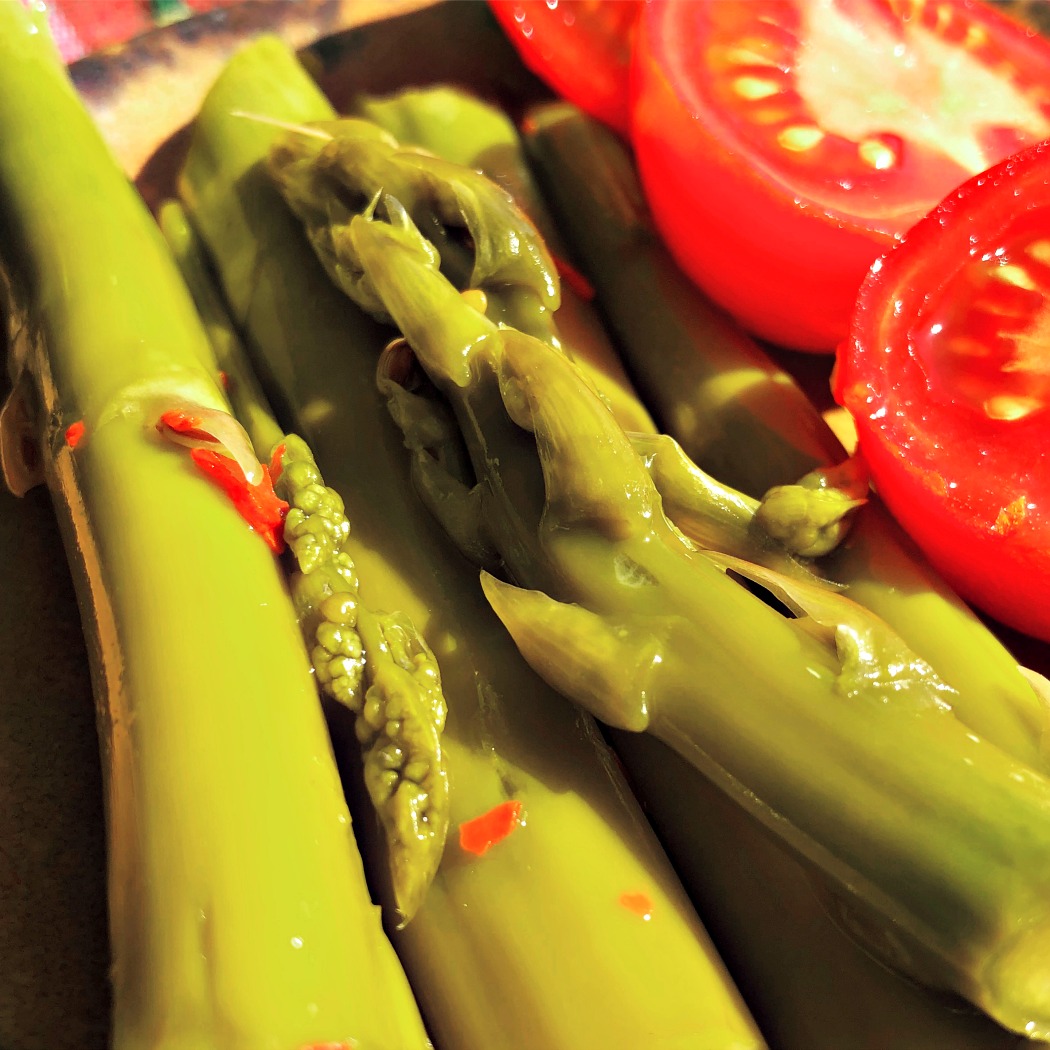How to Make Fermented Asparagus Pickles: A Spicy Springtime Recipe You'll Love!
This post has simple directions for my favorite spicy lacto-fermented asparagus recipe! It’s healthy, full of probiotics, is preserved for longer lasting use, and best of all…simply delicious. Oh! And did I mention? It’s SUPER easy?
I love asparagus. I just absolutely LOVE it! When it becomes available seasonally in the grocery stores, I'm one of the first ones there to snatch some up! And that's exactly what I did last week.
But then, just a day later, I was wandering through the garden of our new home (where things are sprouting up literally overnight), and WHOA!!! I found a wonderfully developed bed of asparagus! Some of the shoots were over three feet tall! I did an ecstatic happy dance and probably gave a little scream too. ;-)
With the large bunch from the store I had purchased, plus having more asparagus coming up every day, I realized I just had my first big harvest of the year! WOOT! I have never ever in my life had this experience of having too much asparagus to do things with!
And you all know how I love fermenting, right?
Well, I decided to ferment some of this asparagus, and here is my recipe for Spicy Pickled (Fermented) Asparagus.
FTC Disclosure: There are affiliate links scattered throughout this article. If you click through and make any kind of purchase, I may earn a small commission at no extra cost to you.
Have a ton of asparagus? Or maybe you just want to create some asparagus pickles that are seriously the most healthy you will ever make? Here’s how to ferment asparagus and make the BEST asparagus pickles at the same time. Love asparagus like I do? You HAVE to try these homemade asparagus pickles! And the recipe is SUPER easy, too!
What is Fermentation, Anyway?
Fermentation is a traditional food preservation method that requires living organisms (yeast and bacteria) to turn food into a healthy option that lasts months. Fermented foods also have loads of extra nutrition and tons of probiotics.
You just can't go wrong when you choose to ferment any extra veggies you have.
If you are unfamiliar with fermentation, you may enjoy reading these articles first:
Fermentation: Why Everyone Should Eat Fermented Foods Daily,
Fermentation Myths (You'll Want to Ferment After Reading This), and
How to Ferment Zucchini (and there's lots more info and recipes on fermentation on the website).
Recipe for Spicy Fermented Asparagus Pickles
One thing to know about fermentation: It makes the spices you use even stronger than normal. Really. So, if you are not really into spicy foods, you can leave the red pepper flakes out, or just reduce them.
Tools You'll Need to Ferment Your Asparagus:
1) A wide mouth quart Mason Jar
2) The lid for the Mason Jar (not the seal--these are both included with the jar)
3) A Pickle Pipe (or other kind of airlock)
4) A Fermentation Weight of some kind
Look at that gorgeous shoot! It's a bit long for picking, but I did it anyway. :-)
Ingredients for Spicy Fermented Asparagus Pickles
1) A bunch of Asparagus, cut into lengths that will leave about an inch and a half head space when packed into the Mason Jar.
2) 1 to 2 tbsp. sea salt or mineral rich Himalayan pink salt
3) Crushed Red Pepper Flakes to taste (I love spice---I used a lot!)
4) Dried Dill (I used about a tablespoon of the dried seeds, which came from our garden. You could use the cut & sifted kind too, but I'd add a bit more.)
5) 1 tablespoon minced Garlic
6) Whey or some brine from a previous similar ferment (optional)---This ingredient simply helps speed the fermentation process up.
7) Filtered Water (I just used our well water)--You want it at room temperature.
Directions for Making Spicy Fermented Asparagus Pickles
Step 1) Wash your asparagus and cut it up.
You want your asparagus spears to fit into the Mason Jar vertically with about an inch and a half head space at the top.
And here is a tip for packing it in: Lay the jar flat and pack it that way. The spears won't be able to go willy-nilly on you!
My asparagus shown here is WAY too long, my friend! I actually cut off the part of the spear that was pithy, and then just cut lengths from there. If you purchase your organic asparagus in the grocery store or farmers market, it will probably be pretty close to the right length. You'll probably just have to cut off the dead ends.
Step 2) Put the salt in the Mason jar with a little water and swirl until fairly dissolved.
Step 3) Add your spices
I added about 1 1/2 tablespoon of sea salt to this ferment. Usually I go a little easy on the salt, especially when I'm using a starter (like I did). But I wanted to be safe, since I've never fermented asparagus before.
Step 4) If using, add your starter.
Here's how to make whey, if you want an unseasoned starter culture for lacto-fermentation (which is what this recipe is)
Step 5) Now add your water until it's completely covering the asparagus spears.
Step 6) Place your weight on top, making sure no spears are bobbing above the surface of the water.
Why? Because mold can (and will) form if any vegetable matter is exposed to the air. I don't worry about the dried spices, but I don't want my veggies touching any air. Check out this article, "What You Don't Want to See on Your Vegetable Ferments" for more information (and my personal opinion) about mold on ferments.
Step 7) Get your airlock set up.
There are different airlock systems out there.
My best favorite for use on Mason Jars is a Pickle Pipe. They are inexpensive and can be found on Amazon. They allow the gases out and no oxygen in and are super easy to use. They're also kind of cute.
You can also get lids made for Mason Jars that have holes punched for a true water airlock. I like these too! You can also get these on Amazon. Here's a set that's good.
Alternatively (and this is how I began my fermentation journey because I wasn't sure how much of the green stuff I wanted to invest in my new hobby at first), you can use the seal and regular lid that goes with the Mason Jar.
The caveat with this method is that you MUST "burp" your lid once or twice a day to allow the gases out. Or you could have problems. Just open the lid slightly, and you'll hear the gases "burping" out. It's kind of fun, actually!
Here's the jar right after getting it all ready. You can see the glass weight on the top. Now--you're ferment will turn cloudy as the days go on, and you may see lots of bubbles, or maybe just a few. It all depends. The cloudiness is a good sign! That means the yeast and bacteria are working!
8) Ferment!
Just put your jar in a quiet corner of your kitchen for several days. I let this ferment go about eight days, until I just had to taste them. PERFECT!
By the way, don't be afraid to do some taste tests along the way. Just be sure whatever you put into your fermenting jar is very clean, and don't double dip (like I am always tempted to do) ;-).
Your ferment is done when you say it's done. I have let my ferments go for up to two months before! And one time I had some fermenting tomatoes in our cold room for about six months! Just be sure to check on it.
When you like where it is, just put the jar in the fridge. The temperature of your refrigerator will slow down the fermentation process to the point where it could seriously last months. Many of my ferments have.
Gotta keep checking the back of the fridge, my friend! lol
9) Enjoy!
That's it! Super easy. Super healthy!
All I can say on this Spring day is, "Yum. Yum. Yum." ;-) Fermented asparagus pickles!
Final Thoughts on Making Fermented Asparagus Pickles
I feel very fortunate to have asparagus growing in my garden this year! Wow! Generally, I was purchasing only enough to use in my salads and recipes, so I am thrilled this year to have enough to preserve and ferment.
What I love about fermentation, besides the important fact that it's super healthy for you, is that it preserves the fresh veggies you purchase or grow. It's truly my favorite form of food preservation.
Do you ferment things? I hope you will give it a try! I know it can be scary at first, but really, I know once you start, you'll be fermenting all the things!
Let us know about your fermentation experiments in the comments!
Hugs, Health, and Self-Reliance,
Heidi
P.S. I hope you'll sign up for the newsletter! You'll never miss a thing, you’ll get immediate access to the free Resource Library, which is filled with eBooks, guides, and resources that are downloadable and printable to help you with your self-reliance journey!
Notice how the color of the fermented veggie has changed too? That's perfectly normal and desirable!
Learn to lacto-ferment your spring vegetables, like asparagus! In this spicy fermented asparagus recipe, you’ll learn facts about fermented foods, how to ferment, and you’ll create a preserved and delicious, high probiotic nutrient dense natural pickle for your family! Super healthy and delicious! Did I mention…EASY? #ferment #fermented #recipes #foods #vegetables #asparagus #pickles #spicy #healingharvesthomestead









